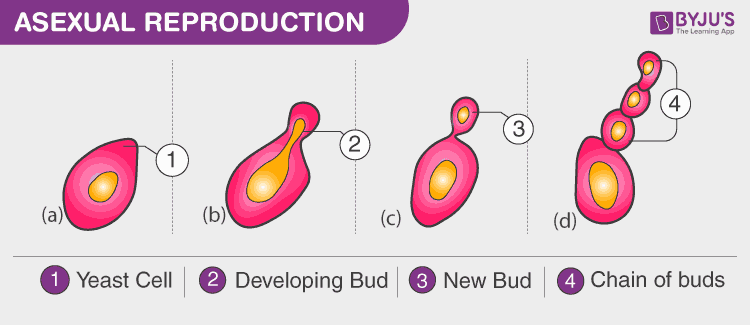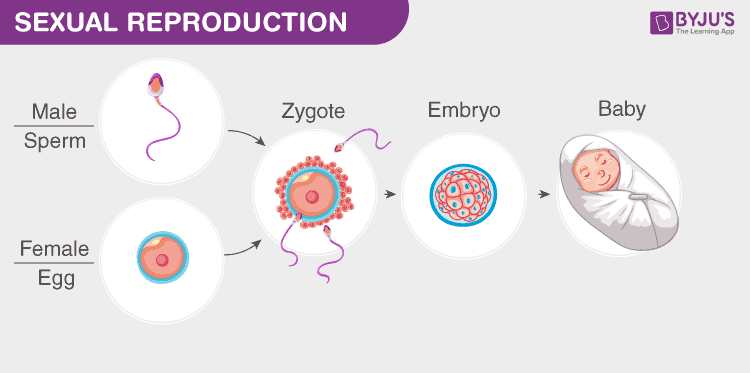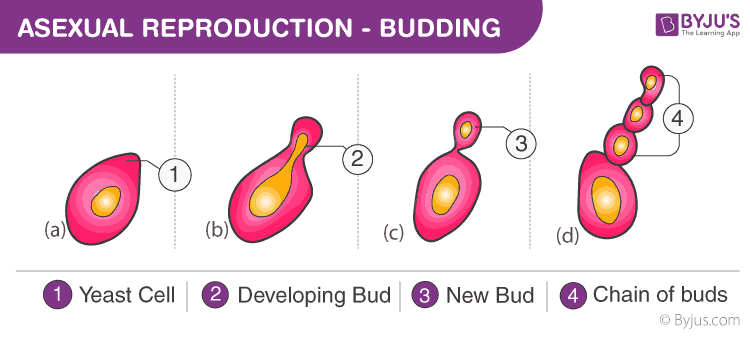According to the CBSE Syllabus 2023-24, this chapter has been renumbered as Chapter 8.
Introduction
Reproduction
Reproduction is of 2 types:
– Asexual Reproduction

To know more about Asexual Reproduction, visit here.
– Sexual Reproduction

To know more about Sexual Reproduction, visit here.
Production of new individuals from their parents is known as reproduction.
To know more about Reproduction, visit here.
The modes of reproduction in plants are:
Asexual Reproduction in Organisms
- In asexual reproduction, organisms can give rise to new organisms without the fusion of gametes.
- Only one parent is involved.
Fission
- It is a type of asexual reproduction that takes place in unicellular organisms like amoeba, paramecium etc.
- A single parent cell divides into two or more daughter cells.
- There are two types:
- Binary Fission: a single parent cell divides into two daughter cells. (e.g. amoeba, paramecium)
- Multiple Fission: a single parent cell divides into many daughter cells. (e.g. Plasmodium)
Fragmentation
- Fragmentation is a form of asexual reproduction or cloning in which an organism is split into fragments.
- Each of these fragments develops into a mature, fully grown individual that is a clone of the original organism.
- For example, sponges and lichens reproduce through fragmentation.
To know more about Fragmentation, visit here.
Budding
- Budding is a form of asexual reproduction in which a new organism develops from an outgrowth or bud due to cell division at one particular site of the parent organism.
- They eventually break away from their parent. For example, hydra and yeast.

For more information on Reproduction Through Budding, watch the below video

To know more about Budding, visit here.
Spore Formation
- The term is also used to refer to the process of reproduction via spores.
- Spores are the reproductive bodies and are microscopic.
- When these spores are released into the surrounding area, they develop into new plants under favourable conditions.
- For example, Fungi and Ferns.
Vegetative Propagation
- It is a type of asexual reproduction in which new plants are produced from roots, stems, leaves and buds. For example, rose and bryophyllum.
To know more about Vegetative Propagation, visit here.
Reproduction in Plants
Sexual Reproduction in Plants
- Sexual reproduction in plants occurs through the fusion of gametes, which eventually gives rise to seeds that develop into a new plant.
- Flowers are the parts of the plant involved in sexual reproduction.
- The male gamete, i.e. pollen grains, are produced by anthers, whereas the female gamete, i.e. ovule, is produced by pistils.
- The male and female gametes meet due to pollination, fuse by fertilization and give rise to a new plant by fruit and seed formation.
For more information on Plant Reproduction, watch the below video

To know more about Sexual Reproduction in Plants, visit here.
Pollination
- Pollination is the act of transferring pollen grains from the male part of the flower, i.e. anthers, to the female part of the flower, i.e. stigma.
To know more about Pollination, visit here.
Types of Pollination
There are two types of pollination:
- If the pollen happens to land on the stigma of the same flower, it is called self-pollination.
- When the pollen of a flower lands on the stigma of another flower of the same plant, or that of a different plant of the same kind, it is called cross-pollination.
To know more about types of pollination, visit here.
Zygote
- In sexual reproduction, a male and a female gamete fuse to form a zygote.
- So in the case of plants, the male gametes present in the pollen grains fuse with the female gamete, i.e. egg.
- This fusion is called fertilization, and the cell formed out of the fusion is called as a zygote.
To know more about zygotes, visit here.
Fertilisation
Fertilization is the phenomena of fusion of the male gamete with the female gamete cell.
Embryo
- The zygote further develops to form the embryo.
- In animals, the embryo grows into an adult.
- In Plants, the embryo further gives rise to the shoot system and root system.
Fruits and Seed Formation
- In plants, post fertilisation, the ovary develops into a fruit and other parts of the flower fall off.
- The ripened ovary forms the fruit.
- The ovules form the seeds.
To know more about Seed Formation, visit here.
Seed Dispersal
- Seeds and fruits of plants are dispersed away by wind, water and animals.
- The seeds show different characteristics depending on their dispersing agent.
To know more about Seed Dispersal, visit here.
Wind
- Seeds are winged and light to get carried by the wind. For example, maple and drumstick.
- Hairy seeds, eg: aak (Madar) and hairy fruit of the sunflower.
Water
- These seeds or fruits normally develop the ability to float in the form of fibrous or spongy outer coats, For example, coconut.
Animals
- Spiny seeds with hooks are attached to the animal body and are hence carried to distant places. For example, Xanthium and Urena
Few of the seeds disperse when the fruits burst out with a sudden jerk, which gets scattered away to a distance far from the parent plant. Eg: Balsam and Castor.
Frequently Asked Questions on CBSE Class 7 Science Notes Chapter 12 Reproduction in Plants
What are the three types of meristematic tissue?
1. Apical meristem2. Lateral meristem3. Intercalary meristem
What are the functions of a permanent tissue?
1. Providing support 2. Protection as well as in photosynthesis 3. Conduction of water, minerals and nutrients
What are the parts of a plant?
Plants typically have six basic parts: roots, stems, leaves, flowers, fruits and seeds.
Comments